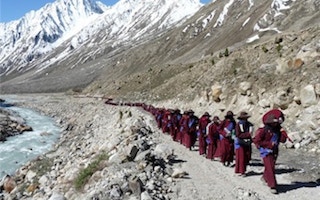Environmental resource conflict – or the potential for it – is never far away in the Himalayas.
In the west of the region, arguments between Pakistan and India over vital water resources in areas bordering the two countries continue. In the east tensions are rising as India expresses concerns about a spate of planned dam-building projects by China on rivers flowing into Indian territory, particularly on the mighty Brahmaputra. Meanwhile Nepal and the north Indian state of Bihar accuse each other of mismanaging water resources that straddle the border.
Regional cooperation is limited and, in many areas, non-existent. In some countries data on vital environmental factors, such as river flows and management, falls into the category of national security and is closely guarded.
The International Centre for Integrated Mountain Development (ICIMOD), founded in the early 1980s and based in Kathmandu, Nepal’s capital, is the only intergovernmental body gathering cross-border environmental information and monitoring climate change across a region stretching from the mountains of the Hindu Kush and Afghanistan in the west to Yunnan in southwest China in the east.
Difficult adaptation
It’s an area described as a climate “hot spot”, with temperatures in many parts rising faster than the global average.
In an ambitious project, ICIMOD has over recent months been trying to gather information on communities’ attitudes and responses across the region to climate change and socio-economic factors which are affecting their livelihoods. More than 6,000 households – mainly in mountain areas – have been involved in responding to a detailed questionnaire.
“Results are still being carefully analyzed and documented”, says Valdemar Holmgren, a climate change adaptation specialist at ICIMOD. “But early indications from one area in Nepal clearly show people are fully aware of changes in climate patterns.”
Click here to read the full story.

















